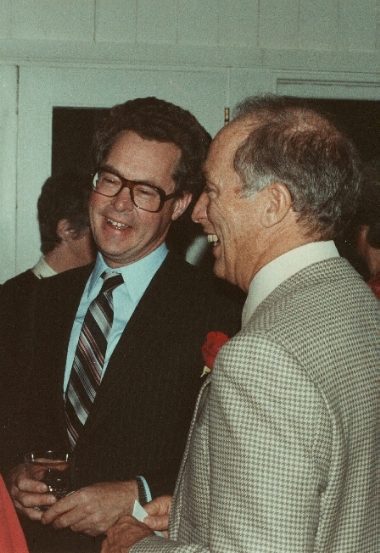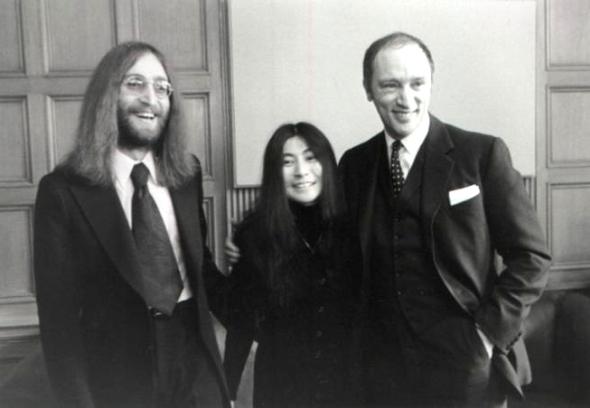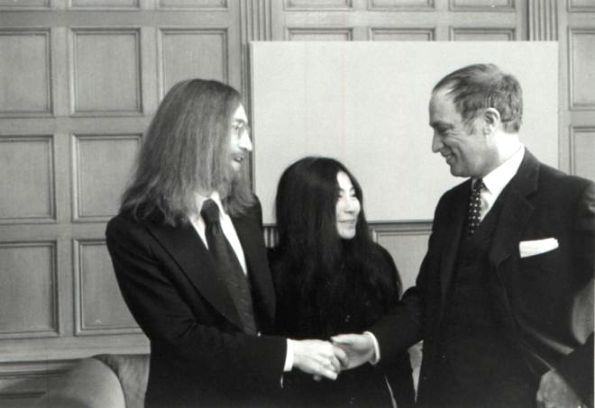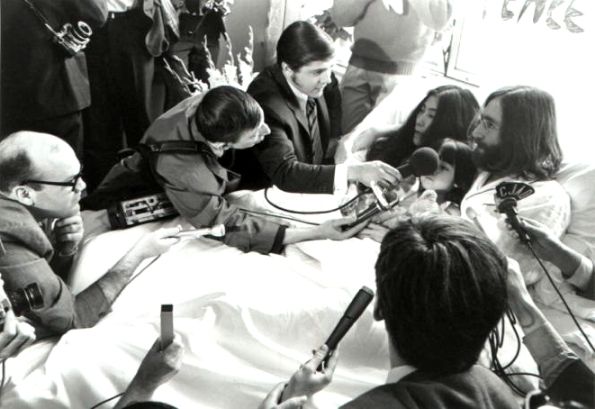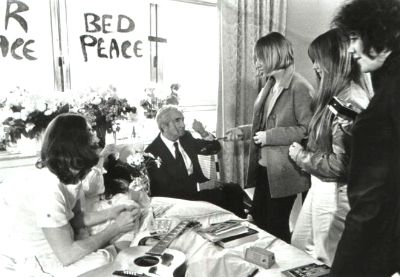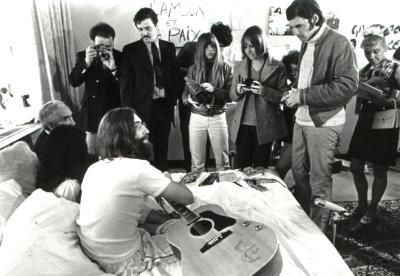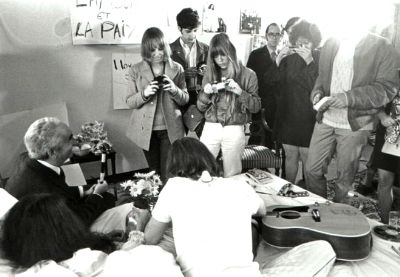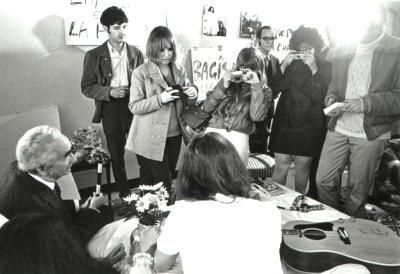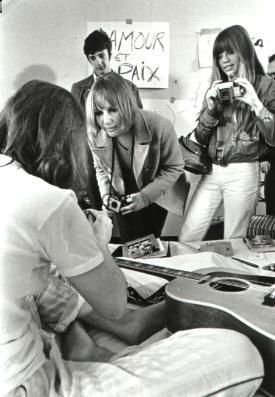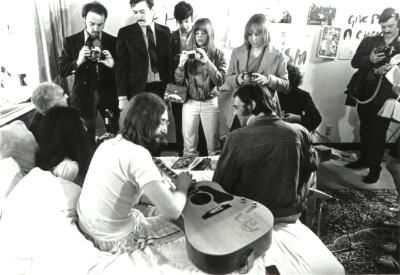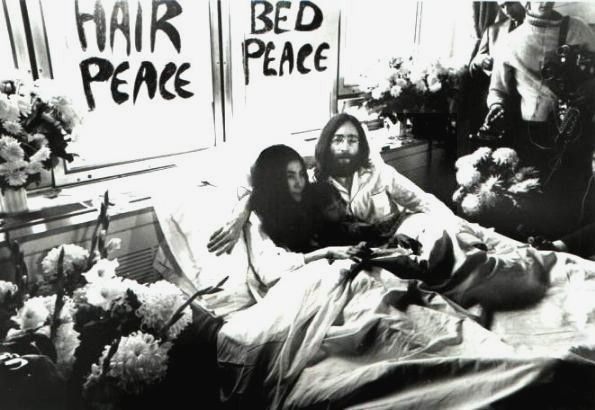|
Researched by John Whelan, Chief Researcher for the Ottawa Beatles Site
Special thanks to the National
Archives of Canada for allowing
John
Lennon and Yoko Ono meet with
A report The meeting on December 23, 1969 between John Lennon, Yoko Ono, Pierre Elliott Trudeau and me would not have happened without the late Jim Davey, and I dedicate this mini-memoir to him. Jim, who had been one of Trudeau’s earliest supporters, was a policy advisor in the Prime Minister’s Office. He had seven teenage children and was an enthusiastic fan of John Lennon and the Beatles. It was Jim who proposed to the Prime Minister’s senior staff that we arrange a meeting between the Prime Minister and the Lennons. In 1969 the Cold War had divided the world into two nuclear-armed rival camps competing for global dominance. Each believed the other was planning to destroy it. In this volatile situation John Lennon apparently decided that the celebrity he had earned as a songwriter and performer could make him an effective advocate for peace. In the spirit of the decade, peace was to be achieved by the relaxation of tensions between individuals, leaders and nations. Since Trudeau’s childhood music and the other arts had been part of his life. His mother founded a club called Les Amis de l’Art and often invited artists to their home. Trudeau’s taste in music was eclectic. I remember him enjoying concerts by Lighthouse, Ian and Sylvia and the Modern Jazz Quartet. He also enjoyed the company of musicians. Among his friends were Leonard Cohen, Barbra Streisand, Liona Boyd, Jena-Pierre Rampal and Guy Beart. Trudeau had been concerned about the Cold War long before he became a Member of Parliament and then Prime Minister. He had been a vocal and consistent proponent of nuclear disarmament for Canada and the other nuclear states. Before joining the Liberal party in 1965 he had been critical of Lester Pearson’s decision to accept nuclear warheads on Canadian missiles. As Prime Minister, he made every effort to improve relations between the nuclear powers, culminating in 1983-84 in a round of visits to major heads of government with a comprehensive set of proposals to end the Cold War. For the Prime Minister’s staff the principal objective of the meetings was not the discussion of music or world peace. It was to be a classic example of the political photo-op. There is a theory among political organizers that if a politician is photographed in the company of a popular celebrity, some of the popularity may rub off on the politician and result in additional votes in future elections. Nobody knows whether this theory works in practice. In 1972 Trudeau came within two seats of losing an election to Robert Stanfield, a politician who had never been photographed with John Lennon or Yoko Ono. But then perhaps there were enough voting John Lennon fans in two of the seats to make the difference. Who knows? Jim Davey’s proposal was approved by the senior staff (of whom I was one) and, with the Prime Minister’s agreement; a meeting was scheduled to consist of 15 minutes of conversation and 15 minutes of photography. Rock stars and Prime Ministers have crowded schedules, often booked months or years in advance. For the Prime Minister Christmas week is more relaxed than usual since the Members of Parliament have gone home to their constituencies and there are no meetings of Parliament or the cabinet. So the meeting with the Lennons was arranged for the morning of December 23. (It is also a slow news period, increasing the chances that the resulting photos would be widely and prominently published.) Since the Prime Minister was sworn in on April 20, 1968, I had served as Special Assistant in charge of speeches and public statements. I had met Trudeau in 1957 and traveled with him in West Africa, the South Pacific and all the provinces and territories of Canada. He was aware of my interests in song writing, theatre and music. As I had not been involved in making the arrangements for the meeting, I was surprised but delighted when he invited me to be the fourth participant.
Timothy Porteous (in the dark suit) having a fun moment with the Right-Honourable Pierre Elliot Trudeau, Prime Minister of Canada. Special thanks to Timothy Porteous for providing us with this lovely photo! As I remember it, the meeting started almost on time but it lasted well beyond the scheduled fifteen minutes. This is an indication that Trudeau was enjoying himself since a Prime Minister can end a meeting whenever he wants. (When I became Executive Assistant in 1970, one of my functions was to "interrupt" meetings that were running overtime, a frequent occurrence.) The time passed very quickly. In an interview Yoko Ono acknowledged that Lennon was nervous, but to me he seemed quite at home. He was utterly charming, highly articulate, an amusing raconteur and, as you would expect, very entertaining. He spoke with a delightful “scouse” accent, which you could cut with a knife and spread on your crumpet. Trudeau, unusually for a politician, was a man of few words, but what he said was always interesting and to the point. Yoko Ono, spoke very little and, when she did, it was to support her husband. My own role was to keep the conversation going in case of awkward pauses, but, since we were all on the same wavelength, it wasn’t difficult to do. After 33 years it is not possible to recall the details of our conversation. As is usually the case when strangers meet, there was an exchange of personal information. It is likely that we talked about In His Own Write as it was Lennon’s best-known non-musical, solo creation. I may have mentioned the book to Trudeau, although I doubt if he was familiar with its contents. Most of the conversation dealt with the world situation and Lennon’s campaign for peace. Although Lennon and Trudeau adopted very different approaches to dealing with the problems of the Cold War, they were in agreement on its fundamental nature. In addition, to threatening the future of the planet and its inhabitants, the conflict was irrational. Neither side could achieve a victory without suffering unacceptable damage to its own population and territory. Somehow a climate of mutual trust had to be created in which disarmament and peaceful diplomatic relations could begin. As the photographs indicate, our conversation ended with expressions of friendship and mutual respect. Lennon said, “If all politicians were like Mr. Trudeau, there would be peace.” Trudeau said, “I must say that Give Peace a Chance has always seemed to me to be sensible advice.” Had he lived, Lennon would undoubtedly have supported Trudeau’s peace initiative of 1983-84. As far as I remember, Lennon did not give Trudeau a symbolic acorn at their meeting. I do not know if he sent one to Trudeau at some other time. I was not involved in arranging the meeting with John Munro but I expect it was organized by the Prime Minister’s office, possibly at Munro’s request. Munro was the Member of Parliament for a Hamilton constituency and the Minister of Health and Welfare. The LeDain Commission, which was considering the legalization of marijuana, reported to him. Lennon’s views on the effects of drug use would have been of interest to Munro - and there were lots of John Lennon fans in Hamilton. Timothy Porteous -- Thanks, Timothy, for your lovely write-up! PHOTO #1
Yoko and John in the corridors of the Parliament Hill in Ottawa, December 23, 1969 Photo #1:
John, Yoko and the Right-Honourable Pierre Elliot Trudeau, Prime Minister of Canada Photo #2: PHOTO #3
Photo #3: PHOTO #4
Photo #4: The CBC News did a lovely in-depth report on Prime Minister Trudeau. Please click on the following active link for their write-up entitled: "One of Our Best and Brightest"
Special thanks to Lynn Farrell of the Montreal Gazette for allowing the Ottawa Beatles Site to e-publish the following photos taken by Tedd Church. It is deeply appreciated, Lynn! Also, towards the end of my research for this project, I discovered that the Montreal Star, a second newspaper company that took some photos of the event, went out of business on October 25, 1979. Two photographs listed in numbers 6 and 15 were done by Edward Morris of the Montreal Star. The National Archives of Canada has retained the negatives and therefore the photos fall under the guise of archival material. You cannot not reproduce any of these photos anywhere on the internet without first obtaining permission from the National Archives of Canada and from the Montreal Gazette. See details on copyright notice at the end of this page. John and
Yoko "Bed-in" at the Beatlology Magazine did an excellent interview with André Perry, who, as most Beatle fans know, produced the famous "Give Peace A Chance" anthem for John and Yoko. The interview was conducted by Andrew Croft, Publisher of Beatlology Magazine. In order to help make this a more complete report for this page, the Ottawa Beatles Site called upon Andrew Croft's generosity for which we are most grateful in allowing us to re-print his excellent article from the May/June 2001 Beatlology edition. Thank you, Andrew! The Recording of Give Peace A Chance If you look on the label of every record released by The Beatles you'll see 'Recorded in England' but you won't see anything about when and where the recording was made. With the recording of Give Peace A Chance at the end of John and Yoko's 1969 Bed-in for peace 'tour' a young record producer from Montreal, Quebec, Canada, was called in to record a song in a hotel room where they were holding their 'event'. Not only was he included on the label, but the name of his studio and its address were also included -- his recording career would never be the same. BM: What was your background in the music industry? AP: My background is that I was originally a jazz musician, producer and owner of a recording studio in Montreal, called Les Studios André Perry. BM: How old were you at the time? AP: I must of have 27, 28. BM: And how did you come to be involved in this particular recording? Was anyone at EMI involved in contacting you? AP: Oh yeah, I got a call from EMI, I used to do a lot of work for them in those days and I was starting to do quite a bit of international work at that time. So when they requested, I imagined through EMI, uh, Toronto I think, and Montreal also, who should they call, or who should do the job? I was called to do it. BM: It has been said that a lot of equipment was shipped from Toronto to do this. Can you tell us a bit about what equipment was used? AP: No equipment from Toronto was shipped at all. I think the confusion is that I was also doing Tommy (the rock opera) with the Ballet Canadien at Le Place des Arts and they wanted to do this on a 4-track, because in those days 16-track was rare. So we were doing this on 4-track and unfortunately my 4-track was in Le Places des Arts for Tommy. What happened is, I rented from RCA Victor here, a 4-track. BM: What equipment was involved? AP: Just a small Ampex board which I had in those days, just four channel in, two channel out. It was recorded on a 4-track Ampex with four microphones -- one for John and his guitar, one for Tommy (Smothers) and two for the room. BM: How many takes were involved with the taping? AP: Well, that's a bit of a mystery, because as I remember there was a run-through just for a sound check. And I think that was broken up also, because John wanted Tommy to play, to do different things. And I think that was it. Then we went right into it. One run-through then one take. BM: Must have been quite exciting. AP: Well, too much was happening to be exciting. We were a lot more worried about the bad conditions, the room, you know it was very, it was a hotel room all made of gyprock you know, and that resonates as you well understand. And the ceiling was extremely low so there was a tremendous amount of distortion. Everybody was banging on stuff. My worry was to come up with something that was going to be, uh, sound decently. I wasn't that excited. BM: When the tapes were taken into the studio, how much studio work was involved in preparing a final track for mastering? AP: Because of the condition of the room being bad, it's as if you put big speakers in such a small enclosure. Too much noise and in a small environment, and what was going on was the tape picking this up. So it wouldn't have been usable. Originally there were no intentions to have any over-dubs done. But when I left John, he looked at me and I said, 'Well, I'll go back to the studio and listen to this and see what it's like.' And then I decided upon myself that the background was a bit too noisy and needed a little 'sweeping.' By this I mean, we kept all the original stuff, we just kind of like, improved it a bit by adding if you like, some voices. So we called a bunch of people in the studio that night, I did, actually that was my decision. And that's probably why John gave me such a credit on the single because I think he thought I took the incentive of doing that. And since it was multi-track I dubbed the original 4-track to an 8-track machine and then used the other 4-track to overdub some voices. BM: Singers and friends? AP: Friends, singers. You know -- call everybody -- they showed up. So the next day I went back to John, made a mix of that I went back to him and they moved everybody out of the room and it was just the three of us, with Yoko, and I played it for him and he thought it was wonderful. Kept it 'as is.' There's another story going around about overdubbing in London, England. Nothing was overdubbed in England. The actual '45' that existed originally is the actual recording. There was also in certain books...references to overdubbing in England, that's not true. The only thing that was overdubbed, like I said, is some of these people, and the reason why I did it, is I wanted to give him some kind of option. You see the point of the matter, it's not that we wanted to cheat anything, it was a question of like, not usable, the condition was absolutely terrible. What we did is by taking the original stuff that was there, and just adding a few voices in a cleaner environment, cleaner recording environment. I was just you know, mad it more...(full). BM: Have you been involved in other Lennon or Beatles-related recordings? AP: No. I met him again, we saw each other in New York when he couldn't get out of the United States. He couldn't get his green card or whatever it was, and was at a...cocktail party, after an Elton John concert in New York and he remembered everything. He was very sweet to me and he actually apologized to me for not coming to the studio because the studio was getting quite famous. We did Saturday Night Fever and we did David Bowie, The Police, Sting, Roberta Flack. We were doing a lot of Canadian acts, Brian Adams, a group called Toronto, I don't know if you remember (them). Chicago (the group) and I can just go on and on. Cat Stevens -- we did three albums. With Rush we did five albums. So the studio was gaining a world of reputation and, of course, he (John) knew of it, and he has somewhat, I guess in the business, followed it. So he kind of apologized for not coming because he said he could not get out of the United States and I was very touched by that. And he had been extremely generous to me, considering he didn't even know me, but the credit that he gave me on the record of course, helped me a lot. I was young and just starting out. And I thought that was wonderful. Also, what touched me most was overdubbing, I mean doing the flipside, you know, (Remember Love), with Yoko and him. That was wonderful because I spent about four-and-a-half hours, just the three of us in the room. And at night, so that was much more personal. You know, a bit of a circus, you know. BM: When did that recording take place? AP: When we finished Give Peace A Chance, I think as I recall, people hung out for a little bit, and then everybody left, and it was just the three of us. We did that possibly around two o'clock in the morning 'til about four in the morning, or even more than that, actually probably from a little earlier than that, one to three or four in the morning. And that was very nice. BM: What was the length of the recording time for Give Peace A Chance? AP: I don't know, but as I recall, I think it must have been around eleven o'clock. But I'm not sure of that. But I know it was fairly late in the evening. Because I showed up I think it was about 5 o'clock, or 6 o'clock in there, to set up. And then people were coming in and out and they were doing interviews...film people also. So as I recall we did it fairly late, ten, eleven, something like that. Because I remember spending the whole night doing the flipside. And we did that very, very fast. As a matter of fact I don't think we even had a playback. There was so many people in the room and it was so noisy and the way I had to record this was with earphones because, you know, I didn't have a control room. There wasn't a room I could set up. You have to take things into perspective, in those days, you're talking a long time ago now. It wasn't like today where you have all these recording tracks and all that. So basically it was quite primitive really. And so it was recorded with earphones even though I had a small pair of speakers for reference but I could not use them because I was in the room with them. I was about twelve feet from the bed. What I like about John was he must have had somewhat of a perception that I was serious and knew what I was doing because he was in full confidence, he didn't know me but he sized me up and he gave me full confidence. I had all this liberty in the world on this thing. It was just totally amazing. 'Cause I remember now, we didn't get a playback. Maybe I might have played it back for him when were in the room by ourselves, I don't remember, probably did. But nevertheless, it's not like he said, 'Well, let's listen to it and let's do it again if it's not right.' He just did it, he looked at me and said 'It's OK?' And that was the end of it. He just sent everybody away. BM: He wanted to capture the moment? AP: Well, that was part of it also he wanted some of the mistakes in it and everything. The only reason there was an overdubbed being done was, like I say again, for the distortion that was being created in the room. Otherwise none of this would have been touched. BM: Do you know if John had any plans to release this as a single immediately or was this something he just wanted recorded for posterity and it happened to become a single? AP: This was shipped immediately to England to be released. BM: Do you have any more thoughts on the event, how it impacted you? AP: For me that wasn't the greatest recording I've ever done because of the conditions. But as far as very proud [I am of] the flip side, because it's a very audiophile sounding kind of recording. Very pure, no EQ, very flat, very sweet, as I must say that's great. I'm very happy I did it, but I think mainly it was more of...Less the circus, you know, I wasn't enchanted with the circus aspect of it. And the circus aspect of it came from the management. It didn't come from John. The management was overwhelmed with what was going on. They were trying to control everything and that part of it was not my 'cup of tea.' When John gave me the credit that he did, we got the call from Toronto saying 'You just won't believe it, we got instructions for international release on the label to say 'Recorded by André Perry, the address, telephone number, the date, where it was recorded.' I said, 'That's incredible!' And I saw some copies of that, from a convention, from South America, different releases and the label reads identical though the rest of the thing is written in Spanish! I was really, really touched by that. I mean I just did what I normally did for anybody -- I would have done the same thing. I was touched that he felt that I guess, that I, what's the word, took on some of the decisions that I did, I don't know exactly where that came from. But he was very generous to me and I was touched by that. Copyright by Beatlology Magazine, 2001. Used with permission by the Ottawa Beatles Site, November 27, 2002. PHOTO #5
Yoko and John having a scrum with media reporters.
Photo #5: PHOTO #6
The person sitting with his tie
next to Yoko and John is Rabbi Abraham Feinberg
Photo #6: PHOTO #7
Photo #7: PHOTO #8
Photo #8: PHOTO #9
Photo #9: PHOTO #10
Photo #10: PHOTO #11
Photo #11: PHOTO #12
Photo #12: PHOTO #13
Photo #13: PHOTO #14
Photo #14: If John Lennon were alive today, there is no doubt in my mind that he would have recorded some special tribute in memory of the fallen lives from the events of the 9/11 tragedy. John would not have condoned such actions and most certainly would have made that point known through public statements via the media. I am very pleased that Yoko Ono had the intuitive insight to release a new re-mixed version of "Give Peace A Chance 2002" which makes lyrical references to the 9/11 tragedy. In spite of all the crazy antics that both John and Yoko did in the late '60s, their "Give Peace A Chance" anthem did hit a nerve with many of the youth from that time. Their actions did put pressure on the United States government to eventually end the Vietnam War. And, it is in keeping with that spirit of John Lennon and Yoko Ono, that we have presented these photos here for you to view. God bless you both and remember everyone to "Give Peace A Chance!" -- John Whelan, Chief Researcher for the Ottawa Beatles Site, November 27, 2002.
Click on the "Peace Symbol" for a free downloadable copy of Yoko's "Give Peace A Chance 2002" from Mindtrain Records! Other Canadian web sites chronicling John and Yoko's visits to Canada (Nota Bene: The Ottawa Beatles Site is not responsible for the content of the first four external sites) COPYRIGHT NOTICE REGARDING THE PHOTOS:
|
 Year One A.P.
(After Peace)
Year One A.P.
(After Peace) 

